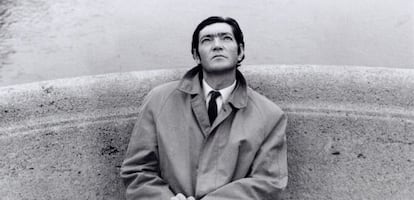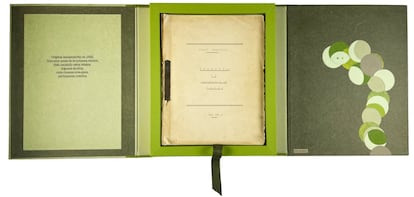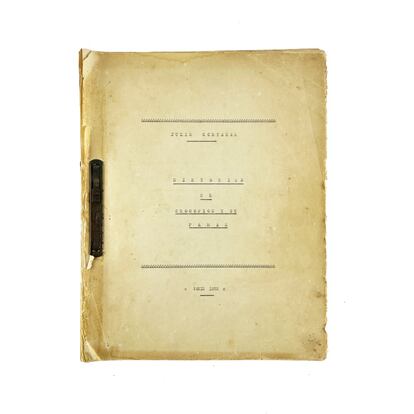Typewritten work by Julio Cortázar with seven unpublished stories is auctioned for $42,120
The texts belong to an early version of ‘Cronopios and Famas,’ written by the Argentine author a decade before the publication of the book and found by chance in a private collection in Uruguay


Julio Cortázar’s unknown cronopios now have an owner. An original typewritten version of what later became the published book Cronopoios and Famas, found in Uruguay earlier this year, was sold on Thursday at auction for $42,120 ($36,000) in Montevideo. The buyer’s name has not been disclosed. The booklet, 60 pages that the legendary Argentine writer typed in 1952, contains 46 texts: 35 that were included in the final version of the book, four that appeared in various magazines, and seven unpublished ones that were hidden for years at the bottom of a box of old papers. A cronopio is a type of fictional person appearing in works by Cortázar.
Cortázar, as researchers have reconstructed, first sent the typescript to Buenos Aires from Paris in mid-1952. He then published the classics End of the Game (1956) and Las Armas Secretas (1959), began working on his famous novel Hopscotch (1963) and published the final version of the cronopios in 1962. Nothing was known about these lost texts, which the son of a collector who died in 2019 in Montevideo found as he went through his late father’s boxes.
“It is a true literary discovery. From some authors, it is fairly common to find unpublished material. Not from Cortázar,” said Roberto Vega, owner of the Hilario auction house in Buenos Aires, who prepared the auction together with the Zorrilla house in Montevideo. The discovery of the unpublished stories had mobilized a small group of experts who worked for a year following the clues of the typescript. Little is known about the family that sold them, who asked to remain anonymous. The owner was an unknown collector, originally from Montevideo, who before dying had told the family that he had some valuable originals in his collection. “They figured that it was from [Jorge Luis] Borges, but it did not show up. The [deceased] man had a lot of material distributed in bookshelves and boxes,” says Vega. No one knew when the man acquired Cortázar’s work, but research has been able to trace how the text arrived in Río de La Plata from Paris.
“We do not know the exact month of this typewritten work from 1952, but Cortázar arrived in Paris in November 1951. That is to say that these magical cronopios were born there, in that mysterious city that Julio always longed for,” says the antiquarian bookseller and researcher Lucio Aquilanti, a bibliographer of Cortázar and expert in his work, who was in charge of tracing the origin of the typewritten work following a request from the original owner. Aquilanti found coincidences: from the typewriter that Cortázar used at the time, a Royal that he used until his wife, Aurora Bernárdez, bought him an Olivetti in 1966, to the handmade corrections that he was able to compare with the originals in his own collection, now preserved at Argentina’s National Library. The rest of the clues were in the author’s personal letters.

At the age of 37, Julio Cortázar led a solitary life as a provincial teacher, with three books published in Buenos Aires that garnered little success. However, everything changed when he permanently moved to Paris in November 1951. The writer, in the words of Aquilanti, arrived in Paris “still single, lonely, disenchanted with the political reality of Buenos Aires at that time and after the appearance of his third and great book, Bestiario. Very possibly already sensing who he would become.” Juan Domingo Perón had just won the elections in Argentina, Cortázar had not yet met Aurora Bernárdez, his wife and great administrator of his estate, he had not yet found a permanent job as a translator and Bestiario had sold only 14 copies. But he wrote and wrote.
In at least four letters sent to friends in Buenos Aires between June and December 1952, Cortázar already talked about those romantic, sensitive and disordered creatures that decades later would rise to become the most celebrated and often translated part of his work. “They are very charming, very sad and very touching. I am very happy with those exercises, but I am afraid that Baudi [the editor and writer Luis María Baudizzone] found them horrendous, judging by his ominous silence,” he said in one letter, dated September 20, to the poet and painter Eduardo Jonquiéres.

“Although the sections or chapters finally included in the 1962 edition are quite different from each other in several aspects, all of them could have in common a certain ascription — even if it is through Cortázar’s personal touch — to the surrealist environment of juxtapositions, free associations, play with humor and absurdity, evocation of dreamlike environments, and so on,” writes the Uruguayan essayist Aldo Mazzuchelli, who collaborated with Aquilanti in the research. In his final analysis, Mazzuchelli concludes: “From the literary point of view, taking into account above all the period and the context of composition, the style, the idiolect of the author and the themes, “there is no solid reason to think that these pages are not authentic.”
The unpublished stories, titled “Inventory,” “Letter from one fame to another fame,” “Automatic butterflies,” “Travel and dreams,” “Tiny unicorn,” “Rage of the mirror” and “King of the sea” include two poems, short stories, small essays that Cortázar played with at that time and a text about the counterparts of the cronopios, the fames, which was left out of the final edition. “They are texts in poetic prose, with a philosophical background, like sociological etchings, written with humor and a certain amount of tenderness. The texts that were pruned in all subsequent editions follow that same line,” Aquilanti said in a conversation with this newspaper.
Auction houses had estimated the sale price at somewhere between $15,000 and $21,000, but the final bid reached $42,120. The document now has a new owner.

Sign up for our weekly newsletter to get more English-language news coverage from EL PAÍS USA Edition
Tu suscripción se está usando en otro dispositivo
¿Quieres añadir otro usuario a tu suscripción?
Si continúas leyendo en este dispositivo, no se podrá leer en el otro.
FlechaTu suscripción se está usando en otro dispositivo y solo puedes acceder a EL PAÍS desde un dispositivo a la vez.
Si quieres compartir tu cuenta, cambia tu suscripción a la modalidad Premium, así podrás añadir otro usuario. Cada uno accederá con su propia cuenta de email, lo que os permitirá personalizar vuestra experiencia en EL PAÍS.
En el caso de no saber quién está usando tu cuenta, te recomendamos cambiar tu contraseña aquí.
Si decides continuar compartiendo tu cuenta, este mensaje se mostrará en tu dispositivo y en el de la otra persona que está usando tu cuenta de forma indefinida, afectando a tu experiencia de lectura. Puedes consultar aquí los términos y condiciones de la suscripción digital.









































